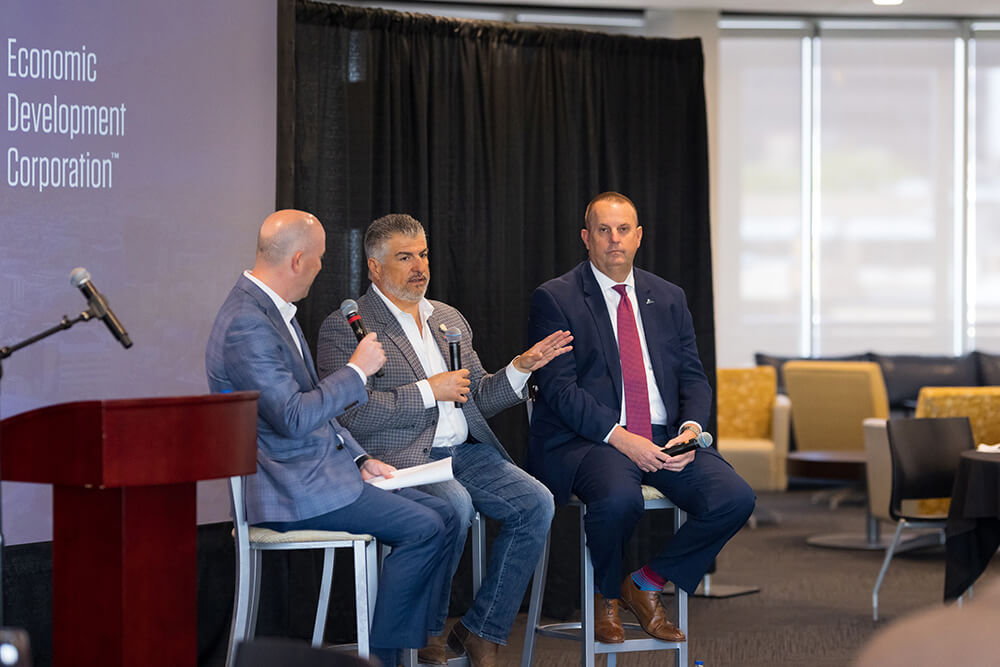Cacique CEO: Amarillo is a ‘must-see’ for CEOs, site selectors

From left: Robert Allen, president and CEO of TxEDC, Gilbert de Cardenas, CEO of Cacique Foods and Kevin Carter, president and CEO of AEDC
AMARILLO, TEXAS — Cacique Foods is building a new facility for producing its Hispanic food products in Amarillo — after touring 16 other potential sites across the nation — because of the city’s unbeatable combination of advantages.
De Cardenas joined Kevin Carter, president and CEO of the Amarillo Economic Development Corporation (AEDC), for a panel discussion last week at a Regional Business Summit sponsored by the Texas Economic Development Corporation (TxEDC). TxEDC President and CEO Robert Allen moderated the panel.
De Cardenas’ parents, immigrants from Cuba, founded the company in California in 1973. De Cardenas took over the company, which produces Mexican-style cheeses, chorizos and crema, in 2009. The Amarillo plant, now under construction, represents an $88 million investment. Amarillo was among the 17 semi-finalists after Cacique considered an initial slate of 123 cities and last of the 17 cities Cacique visited.
If asked, de Cardenas said, he would advise other CEOs considering a move to Amarillo to visit the community before choosing another location.
“You’ve got to come experience it because it’s difficult to articulate it in a way that’s believable until you experience it. If you’re thinking about (moving to Amarillo), you’ve got to come here, you’ve got to talk to Kevin and really look at the area,” he said. “I can tell you that before we got here, before we started the tour, I’m not sure I would have believed some of what I was told.”
Why Amarillo?
Amarillo has a combination of advantages, de Cardenas said.
These include:
- Central location and Central Standard Time — Amarillo, as Carter said, “is in the middle of everywhere,” and the time zone makes it easier to do business on both coasts.
- Workforce — Amarillo has spent millions of dollars developing workforce training programs to produce skilled employees in the region.
- Low cost of living — Amarillo’s cost of living is the 5th lowest in the nation.
- Existing and planned transportation infrastructure — Amarillo has a commercial airport and an east-west highway, Interstate 40, and is looking forward to the expansion of Interstate 27, which will run north-south from Laredo — through Amarillo — to Canada.
- Adequate milkshed — The Amarillo region produces milk that can reach the food manufacturing plant without spoiling.
- Community support for new businesses —Cacique was swayed by the welcome they got from AEDC and others in Amarillo’s business community, de Cardenas said.
- And Amarillo has a friendly, helpful and otherwise “fabulous” culture, he said.
“Being here in Amarillo, you’ve got the milkshed, you’ve got the road system, you’ve got the community, you’ve got the power, and we’re going to benefit from all of that to thrive and make this investment work,” de Cardenas said.
Amarillo has talent
“In our world, you can’t live without talent. Talent is critical — not just talent, good talent,” de Cardenas said. “You can’t win the day without it.”
Amarillo College has developed workforce training and development programs to ensure the region builds a robust talent pipeline. The Amarillo Independent School District, with help from Bell Helicopter Textron, spent $77 million to create AmTech Career Academy, a technical skills training program.
AmTech, which broke ground this week, is going to be “the biggest game changer” in meeting the community’s goal “to keep our talent at home and teach them a skill,” AEDC President and CEO Carter said.
Amarillo is a great location for research and development
R&D — developing new technologies and new products — is important to Cacique’s strategic growth plan, and Amarillo’s central location is prime for R&D because it’s easier to reach the East and West coasts, de Cardenas said. “More and more R&D is coming out of the Midwest because it’s easier to reach those markets.”
Amarillo is open for business
“You have a fabulous community,” de Cardenas told members of the business community attending the TxEDC Regional Business Summit. “Everybody was perfect.”
De Cardenas commended Amarillo on the steps it has taken to anticipate the needs of incoming businesses through the leadership of AEDC, Amarillo ISD and Amarillo College.
“I couldn’t tell you how impressive that is,” he said.
Amarillo is not unique in Texas, TxEDC President and CEO Allen said.
Texas economic development is a relationship business, and the CEOs of other businesses moving into Texas have told Allen how much they appreciated the welcome and cooperation they received from communities across Texas, he said.
“When we shake your hand and commit to X, we mean it. You don’t necessarily see that in other states,” Allen said. “This is an area where Texas absolutely blows the competition away. I get stories all the time from CEOs and their teams in other states that just don’t have that kind of experience. They don’t have that kind, local community support.”
With Amarillo, seeing is believing
De Cardenas and his team had some surprises when they arrived for a tour of Amarillo.
“We weren’t ready for Amarillo to be as well developed as it was,” de Cardenas said. “We thought it was much more of a sleepy little town — and that was not the case at all.”
That’s consistent with some of the misconceptions about Amarillo that Carter said he sometimes hears.
Amarillo has a thriving community with 38 restaurants and a minor league baseball stadium downtown. The city is also fully equipped with state-of-the-art technology.
In the end, something about Amarillo, something intangible, clicked for de Cardenas and his team.
“It’s ‘fit’ and that’s a difficult thing to explain,” he said. “It’s almost a gut feel. But Amarillo was a fit for us, and we’re a fit for you.”